Table of Contents:
Introduction;
Getting Started; Stars
and Constellations; the Moon; Planets;
Meteors and Comets; Deep
Space Objects; Fun (Pictures, etc.)
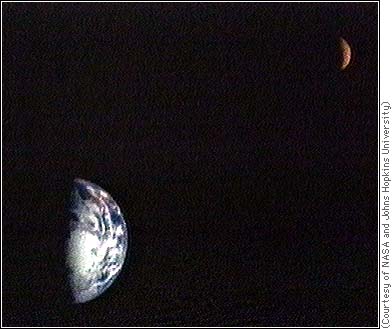
I have been fooling with backyard astronomy for 14 years or so. Don't get out at night as often now but still enjoy seeing things first hand. You never forget the excitement of seeing the rings of Saturn the first time. I teach a class in amateur astronomy in a local Talented and Gifted program each February. Was I trained to be an astronomer? Not really. I took a class in college but nothing made sense. As an adult I became more interested. I checked some books out of the library and started reading. I would read awhile then go outside and look until I figured out what I had just read. Sometimes that took days. (or nights!) You can do the same.
Much of my astronomy is done on the internet now. It isn't as cold in the winter and the mosquitoes don't bite as bad in the summer. I have tried to resist the urge to load this page up with images. It will load faster without them and the links will take you to some wonderful sites where you can learn and enjoy! Remember, observational astronomy isn't difficult. All you need to know is which way is UP! Here are a few links of interest then we'll learn how to find stuff!
Interested in Space exploration? Here are some sites of interest. Mars Pathfinder is what kept our attention July 4th, 1997. The information on this page is the follow up stuff you never see in the papers or TV news that is very interesting and important. See the pictures. Got your red/blue 3D glasses? Also see the Mars Global Surveyor logo and page. This spacecraft is currently in orbit around Mars, performing science on a regular basis. Check this site for current information. Mars Surveyor 98, an upcoming mission. At these sites you can register to receive a free e-mail update about mission status. See what facinating events are coming our way. Also listed is NEAR, an asteroid observation mission.
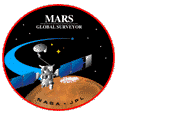
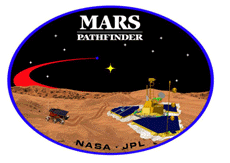
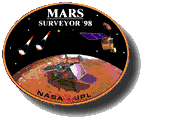

Here are three publications of interest. All are available on the news stands. If you are really interested in learning more about space, the whats, wheres, whys and hows, I suggest you buy one of each, review, and subscribe to your favorite. The articles in SCIENTIFIC AMERICAN are only occasionally about astronomy, however they are well written with nice pictures. It has the plus of offering articles about other scientific interests. The SKY magazine is really good also. The articles may be a little more technical but are very informational and understandable. My personal favorite, and the one I subscribe to, is ASTRONOMY. The articles aren't toooo scientific but get the information across. I have subscribed to Astronomy science I began trying to find out where things were in the night sky. Their web site offers insight to current events you won't want to miss.


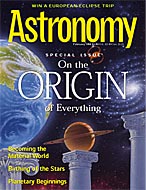
One thing that sometimes causes problems at time is the language. Like every other science, astronomy has developed its own language to describe objects and events. Some it may sound like gibberish unless you know where to find the translation. Take a moment to browse an excellent on-line resource, Astronomy Magazine's on-line Glossary of Astronomical Terms. Want to know what astronomical terms are in a foreign language? Convert between English and four others at The Astronomy Thesaurus.
The most difficult part of learning observational astronomy
is getting started. Most of us have this mental block about anything
with a scientific orientation. With astronomy, it is important to
remember, this was the first science, practiced by our ancestors thousands
of years ago. If they could learn how to find planets and link star
patterns to form pictures, we can too. They didn't even go to school!
Go out in the yard tonight, look up, and really look. Notice the
colors. Did you know stars have different colors? You can really
tell a difference. Can you see the moon? Look for the "seas",
the large dark spots. Can you see bright stars and dimmer stars?
Did you know that light polution, as well as clouds, determines how many
stars you can see? If you have street lights, you may see no stars
or only the brightest ones. If you live in the country, WOW!
When you are not in the glow of city lights you can see over a thousand stars.
When you get through looking, come back to the computer!!
Alright, did that get your interest peaked? Did you find a planet, a comet, a red star, a constellation? Wouldn't you like to be able to? OK, let's start. The first thing an observer has to learn is how to locate herself in the universe. Don't get worried, just learn where north and south are. Go outside and face the point where the sun goes down. That is WEST. When you face west, hold your left arm up and point your finger. SOUTH is thataway! If you hold up your right arm and point your finger guess which way you are pointing? That's right, NORTH is to your right. If you are facing west, where the sun goes down, then you must have your back turned to the EAST. The sun comes up in the east and sets in the west, every day of every year, without fail. Now we can find directions and that means we can start finding stuff!

Stars cover the sky. You don't have to look in any direction but up so we'll start with them. See how they twinkle? That is because the light had to pass through the atmosphere of our planet, bending and twisting it. Stars twinkle, but if you look closely you can see something else, they are different colors. Not red and blue like primary colors in a book, but still colors you can see. The color tells us something about the age and size of the star. Blue stars are hot young stars, red stars are older and larger. Try something neat. Take your binoculars out tonight and look at the stars through them. (Remember to ask your mom or dad if the binoculars are theirs!) Take your time and look at different areas of the sky. Find some bright ones and find them in the binoculars. It is more difficult than it sounds! You can see the colors better that way. Don't expect them to be bigger. Even in the big telescopes stars are points of light. They will be clearer and the colors will be easier to see however.
See how the stars group together. Think of "connect the dots". That is exactly what a constellation is. Thousands of years ago people sat around the camp fires with nothing to do but look up at the night sky. They noticed that the same stars came up night after night but shifted just a little to the west every night. They saw patterns in the stars that seemed to outline things they know. Bears, maidens, scorpions, a bull, all these things and more seemed to dance in the sky to the sound of the crackle of the fire. Do you see patterns of things you know? You can make up your own constellations, they did. You can also claim a star as your own lucky star, memorize the pattern of stars around it, and watch it as it moves across the sky.
How can I learn about constellations over the internet
you ask? Well, some wonderful people have placed pages on the web that
will explain how to recognize different constellations.
A couple of other things of interest on the internet that relate to stars and constellations are:
Aboriginal (Native American) Star Knowledge: Menu
How about the worlds' oldest mystery that involves the pyramids and the constellation Orion?
Now that we know about constellations you may ask "Can I see a planet and where do I look?" The answer is yes, you can see some of the planets without binoculars or a telescope and they are fairly easy to find.
The planets nearer to the sun than our planet Earth are Mercury and Venus. Because they are between us and the sun we never see them travel all the way across the sky. Much of the time they are lost to our vision as they travel behind the sun or across the front of the sun. The time we can see them is when they to one side or the other of the sun as we look from Earth's spot in orbit. We will see them to the East or West, never to the North or South and never overhead. Sometimes they are high above the Eastern or Western horizon, sometimes lower. If we follow them they will appear to rise higher night after night until they reach the highest position, then they rise lower and lower each night or morning until they are lost in the sun. Venus and Mercury are always seen just after sunset or just before sunrise.
Beyond the orbit of Earth are the planets we consider of interest. Any possibility of life, either past or present, is thought to lie in this direction. Of course the planet of most immediate interest is Mars. With an orbit about twice that of Earth, Mars is just outsode the zone where human life can exist without help. Mars has an atmosphere, clouds, water vapor and ice and even man-made machines! For exploration information click on the links in the Getting Started section. Jupiter, Saturn the ringed wonder (and yes, you can see the rings of Saturn in a backyard telescope), Uranus, Neptume and Pluto all cross our night sky. Due to the difference in orbital speeds and the perspective we get from Earth as all the planets orbit we rarely can see more than one or two planets at a time. Sometimes the outer planets are behind the sun, lost in it's glare. They never pass between Earth and the Sun as the inner planets do. To see an on-line rendering of the positions of the planets click here and follow instructions. You can also download a public domain software program (I have never tried this one and make no recommendation or guarntee).
Did
you ever do a school project where you drew the solor system on a piece
of paper? The sun at the center and, in nine rings expanding outward
around the sun, the planets. This is a simplified version of how
things really are. If we could stand on the dot representing Earth
we would see the other planets pass in a line across the sky that would
be straight overhead at the equator. In three dimensions rather than
two we would see some variation in orbits. Some are slightly inclined,
some are more egg shaped but they are approximately in a narrow band much
like the rings around Saturn. Because our Earth is tilted in its
orbit to the sun we can see the planets in their narrow band (called the
plane of the eclipitic). That means planets are not just scattered
around the sky but travel across the night sky in this band. Finding
it is pretty easy. Outside after dark find the direction South.
Face this direction (now you know why we learned how to find directions
earlier!). Your right hand will point to the West, your left hand
to the East. Bring your hands together by raising your arms up and
in front of you so they wind up in front of your eyes pointing at about
a at about a 40 degree angle to the ground. That means just a little
less than half way to pointing straight up which would be 90 degrees.
The arc your arms outline as they travel from East to West is the same
arc where you will find the outer planets if they are visible.
As you stand outside looking up at the stars along this arc, look for brighter
stars that do NOT twinkle. If you see one of these you are likely
looking at a planet. Jupiter will be the brightest, Saturn a yellowish
color and Mars will have a reddish tint. Uranus, Neptune and Pluto
are too dom to see without the aid of a telescope. Check the ASTRONOMY
page to find out which planets are visible right now. You should
be able to tell which ones you have seen.
You
can find pictures and information at:
Solar
System - Astronomy Net Links
The
Solar System
Now that we know where to find the things in the night sky that are predictable, things we can find over and over again, lets look at some things that are unpredictable. Meteors are chunks of rock that have travelled through space and found their way into Earth's gravitational field. If the chunk is not travelling fast enough to break free, gravity sucks it down to Earth. What happens normally is that we see a very bright streak of light pass through the atmosphere as the meteor burns and vaporizes. We may perhaps see a very bright flash of light, or fireball, at the end of the streak of light if the meteor explodes.
Comets
are the "dirty snowballs" of the solar system. Have you ever made
a snowball and accidently dug too deep so there were gravels and sand in
you snowball? That is basically what a comet is, just on a universal
scale. Your snowball may weigh a few ounces or a pound or so.
A comet will weigh many tons and travel at very high speeds. Comets
circle the sun in a very egg shaped orbit, originating in a region at the
fringes of the solor system, the Oort Cloud. A slight tug from one
of the outer planets and it starts a long tumble inward toward the sun.
As the comet passes through the solor system it may pass the orbital plane
of the planets. It may pass near enough to a planet or moon to change
its orbit. A few years ago a comet was caught in the gravitional
pull of mighty Jupiter and sucked into the planet. Ever wonder what
would happen to Earth if a comet hit here? So have some scientists.
Check out Scientific American Exploration: Bang
and Splat: 5/97 and 3D
Comet Impact Simulations. You can find pictures at
Latest
Pictures of Comets.
Another
subject of interest is the meteor showers that you may see mentioned (rarely,
unfortunately) on the TV news. The name stirs up visions of large
rocks raining down upon our planet! Doesn't sound very enticing to
life does it? Meteor Showers are actually Meteorites, small pieces
of dust or ice, passing through the upper levels of Earths' atmosphere.
They create a pale greenish streak of light, sometimes flashing (much smaller
than a fireball) as they vaporize. The most common source of meteorite
material is the stuff that comets leave behind as they pass across the
plane of Earths' orbit. AS Earth passes through these clouds of comet
leavings we see a "Meteor Shower". Meteor showers are pretty well
catalouged. The best time to see these streaks cross the sky is during
these showers, between about 1 AM and 5 AM. You will see some before
midnight, just not as many. Check the Comet
/ Meteor Shower page for a shower, get out your lawn chair, a blanket
a bowl of popcorn and perhaps your binoculars to do a little looking at
the stars. Meteor showers will appear to originate from a given spot
in the sky, listed as a constellation, and spread outward. Remember,
you may also see this at any time you walk outside and look up at night!
They don't just happen in showers. So keep looking up!
There
are some deep space objects visible with the naked eye or through binoculars.
During the winter months check the Orion Nebula, located in the sword of
the constellation Orion. The Andromeda Galaxy is located in the constellation
Andromeda, near the constellation Pegasus. Seen through the naked
eye deep space objects appear as faint, dim objects that improve somewhat
with the backyard telescope. Deep space objects have taken
on new meaning with the Hubble Space Telescope. Check the pictures
links for some wonderful photo's.
For the beginner an excellent web site is available at Astronomy Magazine's on-line site.
To locate information or pictures not listed on this page, and there are MANY more pages on the net, check the search at Yahoo! - Science:Astronomy.
Check in at the Astronomy Cafe.
Return to the top of the page: ![]() E-mail Tom Land:
E-mail Tom Land: ![]()
 Home Page
Home Page